Start learning 50% faster. Sign in now
From (ii), Suman cannot sit at place no. 6, 5, 4 and 2. So, the places left for her are place nos. 3 or 7. From this, we get two possibilities: case (a) & case (b). In case (a), if Suman sits at place no.3, then Jaya will sit at place no. 6. 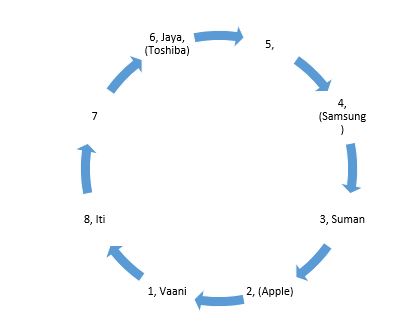 Case(a) In case (b), if Suman sits at place no.7, then Jaya will sit at place no. 2.
Case(a) In case (b), if Suman sits at place no.7, then Jaya will sit at place no. 2. 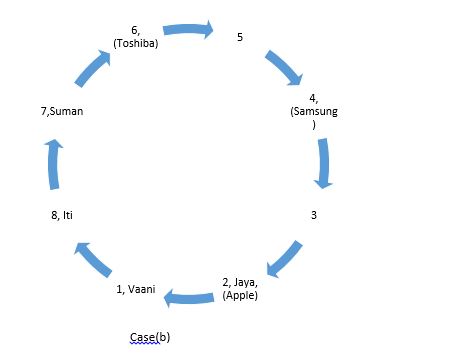 From (iii), it is clear for Kiran and Farah, two consecutive vacant places are required. . In case (a), two consecutive places are place no. 4 and 5, but since neither Kiran nor Farah is having Samsung laptop, so, case(a) is not possible. Hence, we will move forward with case(b). In case (b), two consecutive places for Kiran and Farah are place no. 6 and 5, but since the girl having Dell is second to the left of Kiran, Kiran cannot sit at place no. 6. Hence, it is clear that Kiran and Farah are at place nos. 5 and 6 respectively. It is also clear that the person having Lenovo is at 7 and the person having Dell is at 3.
From (iii), it is clear for Kiran and Farah, two consecutive vacant places are required. . In case (a), two consecutive places are place no. 4 and 5, but since neither Kiran nor Farah is having Samsung laptop, so, case(a) is not possible. Hence, we will move forward with case(b). In case (b), two consecutive places for Kiran and Farah are place no. 6 and 5, but since the girl having Dell is second to the left of Kiran, Kiran cannot sit at place no. 6. Hence, it is clear that Kiran and Farah are at place nos. 5 and 6 respectively. It is also clear that the person having Lenovo is at 7 and the person having Dell is at 3. 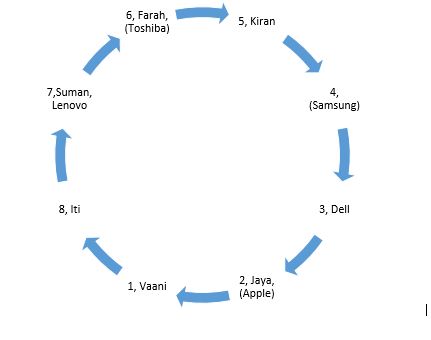 From (iv), it is clear that Heena will sit at place no. 3 and the girl having Compaq laptop will sit at place no. 8 i.e. Iti. So, Iti is having Compaq laptop and Heena is having Dell laptop. From(v), it is clear that the girl having Acer laptop is not an immediate neighbour of Samsung laptop, so Vaani is the one having Acer laptop and the only girl left for Samsung laptop is Geet. Only laptop is left is HP and only girl is left is Kiran. So, Kiran is having HP laptop.
From (iv), it is clear that Heena will sit at place no. 3 and the girl having Compaq laptop will sit at place no. 8 i.e. Iti. So, Iti is having Compaq laptop and Heena is having Dell laptop. From(v), it is clear that the girl having Acer laptop is not an immediate neighbour of Samsung laptop, so Vaani is the one having Acer laptop and the only girl left for Samsung laptop is Geet. Only laptop is left is HP and only girl is left is Kiran. So, Kiran is having HP laptop. 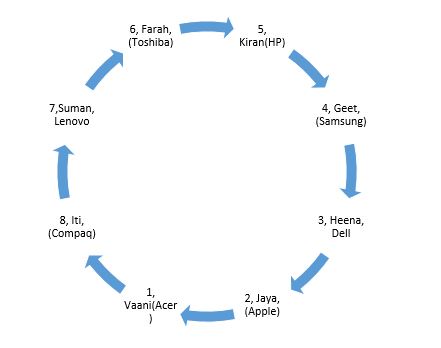 " > From (i), if Vaani sits at place no. 1, then the girl having Samsung laptop sits at place no. 4. Iti is an immediate neighbour of Vaani, so she will sit either at place no. 8 or 2, but she cannot sit at place no. 2 because then person having Samsung will be to her right. Hence, Iti will sit at place no. 8 and the girls having Toshiba and Apple laptops will sit at place no. 6 and 2 respectively.
" > From (i), if Vaani sits at place no. 1, then the girl having Samsung laptop sits at place no. 4. Iti is an immediate neighbour of Vaani, so she will sit either at place no. 8 or 2, but she cannot sit at place no. 2 because then person having Samsung will be to her right. Hence, Iti will sit at place no. 8 and the girls having Toshiba and Apple laptops will sit at place no. 6 and 2 respectively. 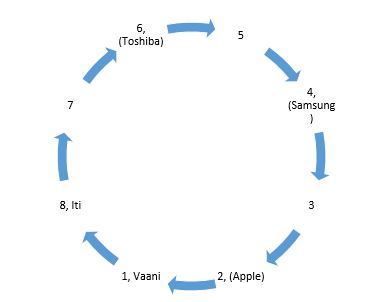 From (ii), Suman cannot sit at place no. 6, 5, 4 and 2. So, the places left for her are place nos. 3 or 7. From this, we get two possibilities: case (a) & case (b). In case (a), if Suman sits at place no.3, then Jaya will sit at place no. 6.
From (ii), Suman cannot sit at place no. 6, 5, 4 and 2. So, the places left for her are place nos. 3 or 7. From this, we get two possibilities: case (a) & case (b). In case (a), if Suman sits at place no.3, then Jaya will sit at place no. 6.  Case(a) In case (b), if Suman sits at place no.7, then Jaya will sit at place no. 2.
Case(a) In case (b), if Suman sits at place no.7, then Jaya will sit at place no. 2.  From (iii), it is clear for Kiran and Farah, two consecutive vacant places are required. . In case (a), two consecutive places are place no. 4 and 5, but since neither Kiran nor Farah is having Samsung laptop, so, case(a) is not possible. Hence, we will move forward with case(b). In case (b), two consecutive places for Kiran and Farah are place no. 6 and 5, but since the girl having Dell is second to the left of Kiran, Kiran cannot sit at place no. 6. Hence, it is clear that Kiran and Farah are at place nos. 5 and 6 respectively. It is also clear that the person having Lenovo is at 7 and the person having Dell is at 3.
From (iii), it is clear for Kiran and Farah, two consecutive vacant places are required. . In case (a), two consecutive places are place no. 4 and 5, but since neither Kiran nor Farah is having Samsung laptop, so, case(a) is not possible. Hence, we will move forward with case(b). In case (b), two consecutive places for Kiran and Farah are place no. 6 and 5, but since the girl having Dell is second to the left of Kiran, Kiran cannot sit at place no. 6. Hence, it is clear that Kiran and Farah are at place nos. 5 and 6 respectively. It is also clear that the person having Lenovo is at 7 and the person having Dell is at 3.  From (iv), it is clear that Heena will sit at place no. 3 and the girl having Compaq laptop will sit at place no. 8 i.e. Iti. So, Iti is having Compaq laptop and Heena is having Dell laptop. From(v), it is clear that the girl having Acer laptop is not an immediate neighbour of Samsung laptop, so Vaani is the one having Acer laptop and the only girl left for Samsung laptop is Geet. Only laptop is left is HP and only girl is left is Kiran. So, Kiran is having HP laptop.
From (iv), it is clear that Heena will sit at place no. 3 and the girl having Compaq laptop will sit at place no. 8 i.e. Iti. So, Iti is having Compaq laptop and Heena is having Dell laptop. From(v), it is clear that the girl having Acer laptop is not an immediate neighbour of Samsung laptop, so Vaani is the one having Acer laptop and the only girl left for Samsung laptop is Geet. Only laptop is left is HP and only girl is left is Kiran. So, Kiran is having HP laptop. 
In which year was the “Namami Gange Integrated Conservation Mission Programme” approved by the Government of India?
International Decade for Women was observed globally between_________
By how much did the Financial Inclusion Index rise between 2021 and 2024?
The all-India poverty ratio was found to be ______ as per the Multidimensional Poverty Index (MPI) 2021.
What is the renewal period for the PM Suraksha Bima Yojna?
Who among the following is the author of the book 'Dollar Bahu'?
How many bones does a human baby have?
What do you call the type of drugs that mimic the natural messenger by switching on the receptor?
According to the ‘Solar Policy 2024’, what is the targeted installed capacity of solar power in Delhi by 2027?
Which state in India celebrates the festival of Bihu?